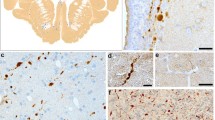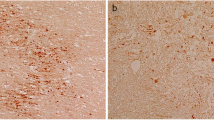Summary
Ubiquitin is a protein that targets proteins for non-lysosomal degradation. It has been found to be present in a number of inclusions characteristic of neurodegenerative diseases. Using the fluid percussion model of diffuse axonal injury (DAI), we now report that the reactive axonal swellings and the retraction balls produced in this model stain positively with antiubiquitin immunohistochemistry. Furthermore, the affected axons become ubiquitin positive quickly (with-in the first 6 h after injury). Anti-ubiquitin immunohistochemistry compares well with the recently reported ability of antibodies to low molecular weight neurofilament proteins to demonstrate reactive axonal change in DAI, and it could provide additional clues to the pathogenesis of axonal transection.
Similar content being viewed by others
References
Adams JH, Graham DI, Murray LS, Scott G (1982) Diffuse axonal injury due to nomissile head injury in humans: an analysis of 45 cases. Ann Neurol 12:557–563
Adams JH, Doyle D, Graham DI, Lawence AE, Mclellan DR (1985) Microscopic diffuse axonal injury in cases of head injury. Med Sci Law 25:265–269
Adams JH, Doyle D, Ford I, Gennarelli TA, Graham DI, Mclellan DR (1989) Diffuse axonal injury in head injury: definition, diagnosis and grading. Histopathology 15:49–59
Adams JH, Graham DI, Gennarelli TA, Maxwell WI (1991) Diffuse axonal injury in non-missile head injury. J Neurol Neurosurg Psychiatry 54:481–483
Cochran E, Bacci B, Chen Y, Patton A, Gambetti P, Autelio-Gambetti L (1991) Amyloid precursor protein and ubiquitin immunoreactivity in dystrophic axons is not unique to Alzheimer's disease. Am J Pathol 139:485–489
Dickson DW, Wertkin A, Kress Y, Ksiezak-Reding H, Yen SH (1990) Ubiquitin immunoreactive structures in normal human brains. Lab Invest 63:87–99
Erb DE, Povlishock JT (1988) Axonal damage in severe traumatic brain injury: an experimental study in the cat. Acta Neuropathol 76:347–358
Hershko A (1991) The ubiquitin pathway for protein degradation. Trends Biochem Sci 16:265–268
Hilton DL, Einhaus SL, Meric AL, White RP, Schweitzer JB, Park MR, Robertson JT (1993) Early assessment of neurological deficits in the fluid percussion model of brain injury. J Neurotrauma (in press)
Manetto V, Perry G, Tabaton M, Mulvihill P, Fried VA, Smith HT, Gambetti P, Autelio-Gambetti L (1988) Ubiquitin is associated with abnormal cytoplasmic filaments characteristic of neurodegenerative diseases. Proc Natl Acad Sci USA 85:4501–4505
Martin JE, Mather KS, Swash M, Garofalo O, Dale GE, Leigh PN, Anderton BH (1990) Spinal cord trauma in man: studies of phosphorylated neurofilament and ubiquitin expression. Brain 113:1553–1562
Pilz P (1983) Axonal injury in head injury. Acta Neurochir (Wien) [Suppl] 32:119–123
Povlishock JT (1992) Traumatically induced axonal injury: pathogenesis and pathobiological implications. Brain Pathol 2:1–12
Strich SJ (1956) Diffuse degeneration of the cerebral white matter in severe dementia following head injury. J Neurol Neurosurg Psychiatry 19:163–185
Sullivan HG, Martínez J, Becker DP, Miller JD, Griffith R, Wist AO (1976) Fluid percussion model of mechanical brain injury in the cat. J Neurosurg 45:520–534
Yaghmai A, Povlishock JT (1992) Traumatically induced reactive change as visualized through the use of monoclonal antibodies targeted to neurofilament subunits. J Neuropathol Exp Neurol 51:158–176
Author information
Authors and Affiliations
Additional information
Supported by a grant from the NINDS (NS01230) and by a grant from the Baptist Memorial Health Care Foundation
Rights and permissions
About this article
Cite this article
Schweitzer, J.B., Park, M.R., Einhaus, S.L. et al. Ubiquitin marks the reactive swellings of diffuse axonal injury. Acta Neuropathol 85, 503–507 (1993). https://doi.org/10.1007/BF00230489
Received:
Revised:
Accepted:
Issue Date:
DOI: https://doi.org/10.1007/BF00230489




